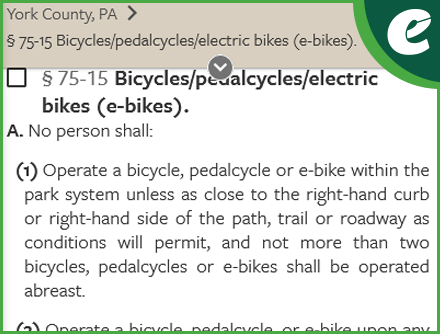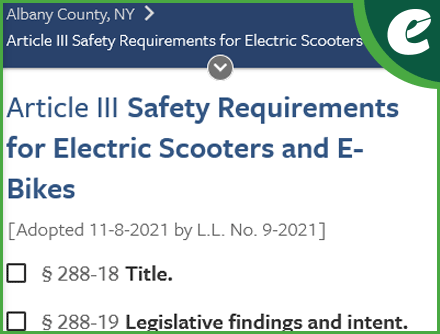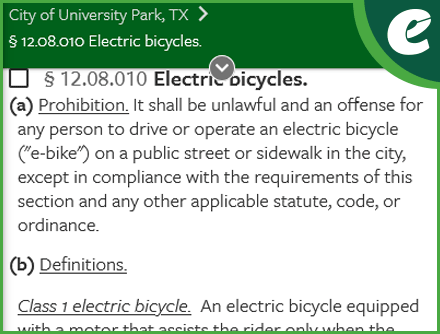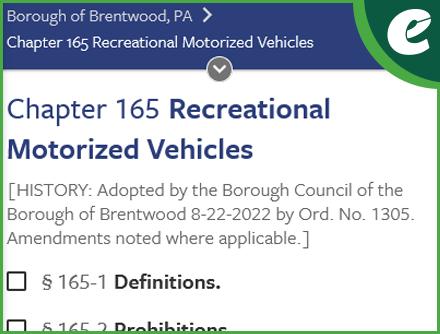The Rise of E-Bikes
Electric bikes, or e-bikes, have surged in popularity in recent years, revolutionizing how people commute, exercise, and explore urban spaces. With powerful electric motors assisting pedal power, e-bikes offer an accessible and eco-friendly transportation option. But this rapid rise has also presented challenges for municipalities as they work to update laws, adapt infrastructure, and balance the needs of both traditional cyclists and e-bike riders.
View sample e-bike legislation >
Why E-Bikes Are Gaining Popularity
E-bikes offer several advantages that are making them an attractive alternative to cars and public transportation. Some of the factors contributing to their rising popularity include:
Health Benefits: Riders can choose how much pedal assistance they want, allowing them to get some exercise while not overexerting themselves.
Environmental Impact: Producing zero emissions, e-bikes are seen as a more sustainable option than cars. This aligns with growing global interest in reducing carbon footprints.
Accessibility: E-bikes are appealing to a broader demographic, including older adults and those with limited mobility, as they require less physical effort than traditional bicycles.
Cost Efficiency: While e-bikes may have a higher upfront cost, their long-term savings on fuel, parking, and public transport fees make them a cost-effective option.
E-Bike Legislation Challenges for Municipalities
With the rise in e-bike use, cities and towns are faced with challenges related to safety, infrastructure, and legislation. The rapid adoption of this technology means municipalities must quickly adapt to new transportation trends.
Regulation and Enforcement: In response to these challenges, local governments are updating municipal ordinances to regulate e-bike use. This includes setting speed limits, designating specific areas for e-bike riding, and distinguishing between different classes of e-bikes.
Safety Concerns: E-bikes can reach higher speeds than traditional bicycles, which can lead to safety issues for riders and pedestrians. The speed differences between e-bikes and regular bicycles create potential risks on shared pathways that could lead to accidents and conflicts.
Infrastructure: Urban infrastructure often isn’t designed to accommodate the influx of e-bikes. Cities must rethink bike lanes, road sharing, and parking facilities to ensure both traditional cyclists and e-bike riders can navigate safely. Many municipalities are expanding bike lanes, creating separate paths for e-bikes, and increasing signage.
How Local Governments are Adapting: New and Updated E-Bike Ordinances
To address the growing e-bike trend, municipalities have introduced various regulations. These ordinances focus on safety, infrastructure, and user responsibilities. Here are some examples:
Shared E-Bike Programs: E-bike sharing programs, similar to bike-sharing schemes, are becoming increasingly popular in cities like Paris and Washington D.C. Municipalities are partnering with private companies to provide e-bikes for rent, encouraging a more sustainable and accessible mode of urban transportation.
Speed Regulations: Cities like New York and San Francisco have implemented speed limits for e-bikes in high-traffic areas. For example, many municipalities limit e-bike speeds to 20 mph on bike paths and shared lanes, helping reduce the risk of accidents.
E-Bike Classification: Many local governments are adopting a three-tier classification system to differentiate e-bikes based on speed and motor power. This system helps determine where each type of e-bike can legally be used. For example:
- Class 1: Pedal-assist only, with a maximum speed of 20 mph.
- Class 2: Throttle-assisted, with a top speed of 20 mph.
- Class 3: Pedal-assist, but can reach speeds of up to 28 mph.
Parking and Charging Infrastructure: Some cities are updating their public spaces to accommodate e-bike parking and charging. This involves installing bike racks with integrated charging stations in central locations. San Diego and Portland are two cities that have invested in such infrastructure.
Resources for Municipalities and Riders
To navigate the growing e-bike trend, both local governments and riders can turn to several resources:
National Association of City Transportation Officials (NACTO): Offers guidelines for cities on e-bike infrastructure and regulation.
PeopleForBikes: Advocates for bike-friendly policies and provides resources on e-bike classifications and municipal ordinances.
International Transport Forum (ITF): Provides global case studies and reports on the integration of e-bikes into urban transport systems.
The Future of E-Bikes and City Infrastructure
E-bikes are here to stay, and municipalities must continue adapting to this evolving trend. As cities invest in better infrastructure and create comprehensive regulations, the positive impact of e-bikes will likely outweigh the challenges. With the right policies in place, e-bikes can help cities reduce congestion, cut down on emissions, and create more sustainable, healthier communities.
The rise of e-bikes signals a shift towards more eco-friendly urban transportation, and as municipalities adjust, the future of e-biking looks bright.
Useful examples of e-bike legislation from the eCode360® Library
If your community is considering enacting or updating zoning ordinances to address e-bikes some useful examples can be found in our eCode360 Library, including:
Is your code on a schedule?
Did you know you can set up a regular update schedule, so you don’t have to worry about compiling materials or taking up time and resources of your staff to do the updates yourself? As your municipality passes legislation, send it to General Code and we’ll take care of the rest. It’s just that simple!
For tips that will allow us to process your code updates most efficiently, click here.
Questions about updating your code?
Our Client Care team is available to explain the options and benefits of scheduled code updates or any other code-related questions you might have.






